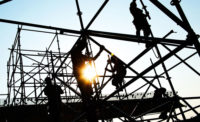Date adopted: July 2, 2018
Why this standard is important
The International Safety Equipment Association (ISEA) reports struck-by falling objects result in hundreds of fatalities annually and thousands of injuries. In 2016, the Bureau of Labor Statistics reported there were 255 fatalities and 47,920 injuries from dropped objects in the United States, making this the third-leading cause of injuries on the jobsite, according to OSHA. Compared to 2015, deaths from dropped objects were up approximately 3.24 percent, and injuries increased by 6.85 percent.
Scope of standard
ANSI/ISEA 121 – 2018 describes four categories of equipment; anchor attachments, tool attachments, tool tethers, and containers (buckets and pouches). The scope of this standard includes tethering systems subsequently installed to the tools and anchors after original manufacture. Primary tools (hand tools, fasteners, power tools) and primary anchors (human body, lifts, structure) are specifically excluded from this standard.
ANSI/ISEA 121 -2018 does not address netting, barricades and toe boards. It does not address head protection, foot protection, and eye protection. It also does not address hoisting or lifting requirements for material handling.
Key definitions
- Anchor Attachments: Protections that are applied to anchors being used at height to create secure connection points for tool tethers and which are not integral to that anchor. An anchor is the beginning point -- human body or structure -- at which a tether is attached and is relied upon to prevent a tool from dropping
- Tool Attachments: Protections that are applied to tools being used at height to create secure connection points for tool tethers and which are not integral to that tool.
- Tool Tethers: A length of material with at least one connector on each end that will connect a tool to an anchor.
- Containers: Containers can be a bucket, tool bag or similar device used to hold or transport tools or other equipment. A container static test plate is a fixture such as a steel plate that is smaller than the footprint of the bottom of the container.
Key standard takeaways
- Cleaning should be done based on manufacturers’ recommendations. Some chemicals, cleaners and procedures can affect the integrity of the products.
- All components (anchor attachments, tool tethers, tool attachments, containers) should be inspected prior to each use for damage or wear due to normal use, drop impacts or contact with sharp objects. If any part is worn or shows signs of wear, it should be removed from service. Consult manufacturer’s instructions and authorized site personnel for specific inspection intervals and personnel requirements.
- If unusual conditions prevail (such as temperature extremes outside the specifications), prolonged exposure to the environment (such as UV rays or salt air), exposure to chemicals, or signs of abuse or damage to the components due to high usage or dropped tools occurrences, the degree of protection may be reduced. Consult manufacturer’s instructions and authorized site personnel.
- Be cautious of how much weight is attached to a user from either a single drop tool or a multi-drop of tools. Use of tool tethers and containers should not mitigate other safety requirements such as netting, safe working zones, or personal protective equipment and the awareness of workers below. Not all tools might be tethered and employee awareness of dropped hardware could still be a concern. Be aware of area requirements to make the best possible decision regarding use of tool tethers and containers.
- Users of this type of equipment must receive proper training and instructions, including detailed procedures for the safe use of this equipment in work applications. For these precautions, consult manufacturer’s instructions and authorized site personnel.
Prevention practices
According to DROPS, every jobsite is different, with its own particular hazards. Establish your own prevention plan that includes inspections before and after working shifts to help you identify potential areas of risk. Also:
- Take note of particular weather conditions that can elevate risk;
- Train all employees on potential hazards;
- Create your own hazard identification tool;
- Conduct regular hazard hunts;
- Consider the use of safety nets and tethers for tools;
- Create an easy system for reporting all incidents to help you track trends and locate specific areas where dropped object risks are greater;
- Promote active participation in your prevention program and reward employees who participate regularly.
Case study
In 2010, Chevron adopted a program called DROPS to prevent injuries to workers and damage to offshore oil rigs from objects dropped from elevated work stations. Chevron is committed to Incident-Free Operations (IFO). This can be achieved only by working as a team with Chevron contractors.
Chevron acknowledges the valued contribution made by its contractors and the Dropped Objects Prevention Scheme (DROPS) in the production of a DROPS booklet.
Chevron developed the booklet describing the management of objects that could fall and harm people or damage property during operations performed on all facilities under Chevron operational control. Specific reference is made to the Chevron Global Dropped Objects Management Guidelines (Issue 2010) and the cross-industry Dropped Objects Prevention Scheme.
The contents of the booklet apply to all Chevron personnel, contractors and subcontractors working on sites under Chevron operational control.
The program’s strategy is to create site-specific dropped objects work groups; identify and assess problem areas; develop and implement an action plan; and monitor results and continually improve.
Among the program’s recommended actions: 1) Create a dropped objects work group specific to the site; 2) Introduce working at height procedures;.3) Introduce specific toolkits for working at height and implement processes to account for tools; 4) Raise overall dropped objects identification and mitigation among the workforce; 5) Train relevant personnel to identify and mitigate dropped objects processes; 6) Secure tools from dropping to lower levels; 7) Review and revise Job Safety Environment Assessment (JSEA) guidelines for dropped objects potential; and 8) Inspect all overhead equipment and locations for loose items that may present a hazard during maintenance activities.
Compliance resources
International Safety Equipment Association https://safetyequipment.org/
ISEA is the leading association for personal protective equipment and technologies that enable people to work in hazardous environments, and an ANSI accredited standards developing organization. The association works closely with manufacturers, test labs, subject matter experts, end-users and government agencies in the standards development process. The ANSI/ISEA 121 – 2018 standard can be purchased from ISEA, 1901 N. Moore Street, Suite 808, Arlington, VA 22209; (703) 525-1695; e-mail: standards@safetyequipment.org.
DROPS http://dropsonline.org/
DROPS is an oil and gas industry-wide initiative focused on preventing dropped objects. DROPS is a global work group, represented by 200 operators, contractors, service companies and industry bodies, all sharing commitment and enthusiasm for the common goal of dropped object prevention.
Electronic Library of Construction Occupational Health and Safety
http://elcosh.org/document/3617/d001180/chevrons-dropped-object-prevention-program.html
Sponsor:
www.ergodyne.com
800-225-8238


